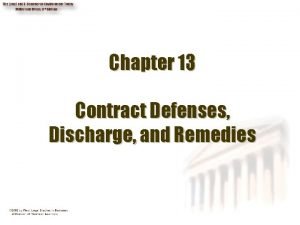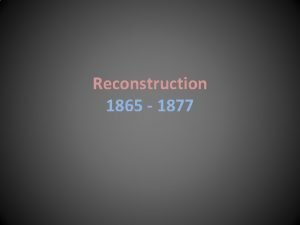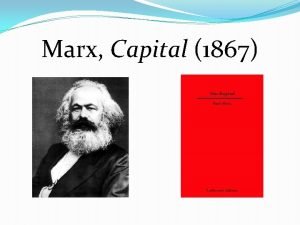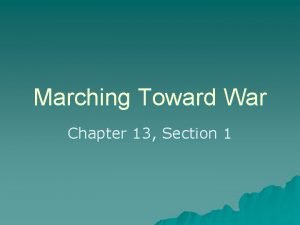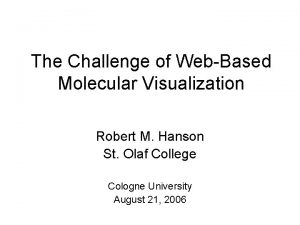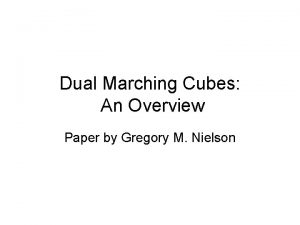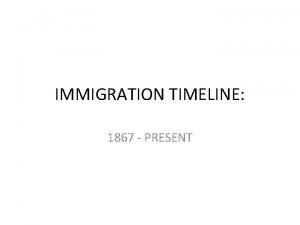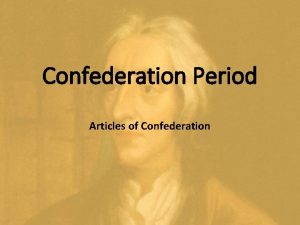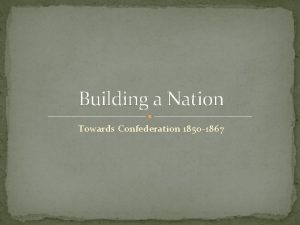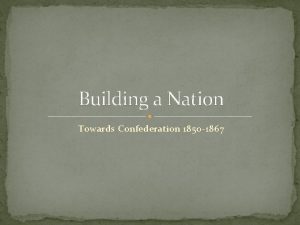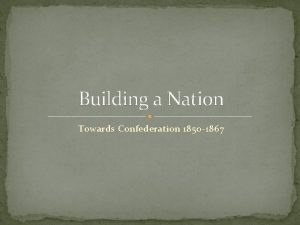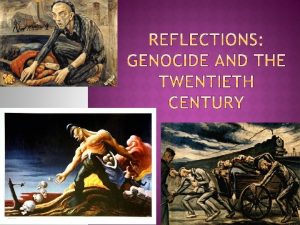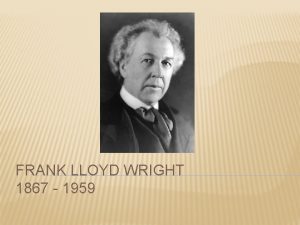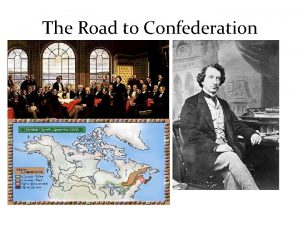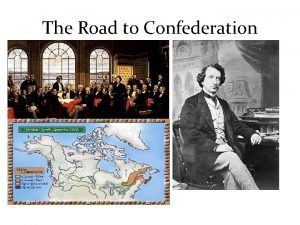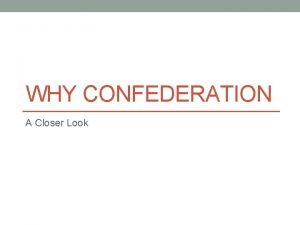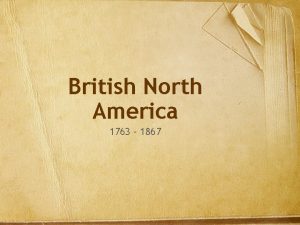Marching towards the Twentieth Century Timeline 1867 Confederation




















- Slides: 20

Marching towards the Twentieth Century ~ Timeline ~

1867 - Confederation • Ontario, Quebec, New Brunswick, Nova Scotia (4 Provinces in total) form the New Canada • John A. Mac. Donald is Canada's first Prime Minister

Why did these four provinces join Confederation? 1. 2. 3. Manifest Destiny and Anti American sentiment (due to US Civil War) The End of free trade with the United States Canada needed more independence to deal equally with America and get the best trade deals. Building the railway– the promise of railways convinced many provinces to join Confederation.

The British North American Act (1867) i. iii. What is it? The document that created the country of Canada (divided the powers between the provinces and a national government, set up the forms of government, gave Canadians a degree of independence – BUT still very closely tied to Britain) The type of government established, federal system gave more power to the national level of government. Why would Provincial rights be important? The Provinces involved were all very different, and wanted to sustain their unique identity while still being part of Canada Provinces were given powers over education and religion. This was particularly important to the province of Quebec

1870 • Canada purchases Rupert's Land (made up of Manitoba and North West Territories) from the Hudson’s Bay Company • Metis uprising in Manitoba led by Louis Riel – Riel Rebellion, results in Manitoba Act, brings Manitoba into Confederation and guaranteed rights of language and religion. However, execution of Thomas Scott results in Riel fleeing to the United States.

Marching towards the Twentieth Century – Timeline Con’t • 1871 - BC becomes a province – Why? Because of the promise of a Railway • 1872 - John A. Mac. Donald envisions a Canada that is connected from east to west (sea to sea) – Transcontinental railway started • 1873 - Mac. Donald defeated at polls amid cries of scandal over railroad contract. – Alexander Mackenzie is first Liberal Prime Minister – PEI becomes a province

1876 - The Native Treaties and the Indian Act • • In order to “settle the native question” the Canadian Government signed The Numbered Treaties which gave the natives certain concessions in exchange for taking all their land The Indian Act of 1876 denied Natives the right to vote, practice religious ceremonies and own property if they identified themselves as Status Natives. Residential Schools were established in 1890 to assimilate Native Children. Run by churches and/or the government, they stripped the Natives of their language, religion, customs and culture Assimilation – to become part of the dominant culture.

1878 • Mac. Donald was re-elected Prime Minister on the basis of his National Policy which included: • protective tariffs (tax added to American goods) • completion of the railway • large-scale immigration to the west. Dominion Lands Act– For $10, any adult male can purchase 64 hectares of prairie farm land. They must construct a shelter and live on their land at least six months a year for three years.

1885 • The CPR railway is completed but at the expense of 1500 Chinese lives. • Federal government courted Chinese to come to Canada to perform the most dangerous tasks in the construction. Chinese were paid half the wages of their Canadian counterparts and continued to be discriminated against after construction was completed. • A head tax was imposed to discourage any further immigration of Chinese. • North West Rebellion, quashed by Mac. Donald, Riel hung as traitor

Marching towards the Twentieth Century – Timeline Con’t • 1896 - Wilfred Laurier became Canada’s 7 th Prime Minister This man has a vision “…that the twentieth century will be the century of Canada. ” • 1900 - Seven provinces, population of 5, 200, 000 most people were farmers, involved in logging fishing, and construction (new cities, sewer systems, railways)

Canada at the Turn of the Century 1900 -1914

What was Canada Like? • In 1900 Canada only consisted of 7 provinces • The population was 5, 200, 000 • Toronto, Montreal and Halifax were the biggest cities • The West was comprised of small pioneer cities like Winnipeg, Calgary and Vancouver

Canada at the Turn of the 20 th Century • 63% of the population lived in Rural areas • Farming was the main occupation • Logging, Fishing and Construction were also popular jobs • Women worked as teachers, store clerks, in factories or on the farm

Community focused life… • Lives were usually centered around family and the local community • There was little entertainment outside the local sports teams and the church • Travel was often limited to a horse and buggy

The Political Scene… • • The elections of 1896, which made Liberal Wilfrid Laurier prime minister Marked a major turning point in Canadian history. Laurier's rise to power coincided with an economic upswing More railways were built, the West was settled, and industries flourished The prairies joined Confederation (Alberta and Saskatchewan, 1905) On October 10, 1911, Sir Robert Borden became the 8 th Prime Minister of Canada He was a Conservative who led Canada into WWI

The Economy • Construction of railways and the expansion of central Canadian industries fuelled the economic boom • Under Laurier large-scale settlement of the West began • The increasing demand, in industrial countries like Great Britain, for Canadian natural resources was a major reason for Canada's prosperity

The Immigration Wave • Development of the West depended on increased immigration • Laurier's government, worked continuously to promote Canadian immigration in both Europe and the United States by advertising “Free Land” • Of the 2 million people who arrived in Canada between 1896 -1911, approximately one million moved to the West • New immigrants transformed the ethnic composition of the country

Urbanization • Immigration also had great effects on industrial centers like Montreal and Toronto • Cities across the country grew rapidly creating more and more jobs • The working and living conditions of the labouring class was often poor • City councils struggled to keep up with the growth i. e. transportation, housing and sanitation

Urbanization con’t… • Slums were created in many cities, with poverty, overcrowding and unsanitary conditions • The Catholic Church saw the drawbacks of city life and felt that cities were “breeding grounds for disease and death”

In Class Activity Immigration and Urbanization • Read pages 22 – 25 “New Immigrants” • Answer Focus Questions 1 -4 • Read pages 40 -42 “City Life” • Answer Focus Questions 1 -3
 Parker v twentieth century fox
Parker v twentieth century fox Parker v twentieth century fox
Parker v twentieth century fox Twentieth sunday after trinity
Twentieth sunday after trinity Donatello timeline
Donatello timeline Tenure of office act 1867
Tenure of office act 1867 Capital 1867
Capital 1867 What country did impressionism originated from
What country did impressionism originated from Lister 1867
Lister 1867 History of tourism 4000 bce
History of tourism 4000 bce 1934-1867
1934-1867 Hamilton high school band
Hamilton high school band Chapter 13 section 1 guided reading marching toward war
Chapter 13 section 1 guided reading marching toward war Perry high school marching band
Perry high school marching band Marching cubes
Marching cubes Perry high school marching band
Perry high school marching band Supine marching
Supine marching Fungsi marching
Fungsi marching Sympathy for the devil
Sympathy for the devil Cubical marching squares
Cubical marching squares Dual marching cubes
Dual marching cubes Marching band terms
Marching band terms

